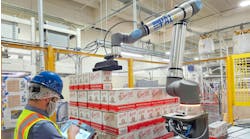Stephen McKinley is a co-founder and vice president of operations for Ambi Robotics. He’s responsible for deploying fleets of robotic solutions to the company's global partners. McKinley is a post-doctoral researcher at the University of California (UC), Berkeley. His research has spanned low-cost robotic arms for reinforcement learning and learning from demonstration, gripper design, radiation oncology, agricultural robotics, surgical robotics and legged locomotion. McKinley holds a doctorate in mechatronics design from UC, Berkeley, a master of science degree in mechanical engineering design and materials from UC, Berkeley, and a bachelor of science degree in mechanical engineering from University of Massachusetts, Amherst. During his graduate studies, he was the winner of the National Science Foundation’s Integrative Graduate Education and Research Traineeship (IGERT) fellowship, awarded to facilitate interdisciplinary research.
What are three key things that a machine builder, system integrator or manufacturer should know about your organization?
Stephen McKinley, co-founder and vice president of operations, Ambi Robotics: There is a robotics renaissance taking place in the warehouse, and Ambi Robotics works directly with customers to manage their transformations toward automation. Ambi Robotics connects cutting-edge technology to core material-handling problems in a way that is user-centric and customer-focused. Our simulation-to-reality artificial intelligence methods allow us to automate a broad variety of tasks that would have been previously impossible. Tasks that involve complex repetitive manipulation of unknown objects have become our specialty.
What new technologies are driving product development and why?
Stephen McKinley, co-founder and vice president of operations, Ambi Robotics: There are several technologies driving the flexible robotics revolution.
Simulation-to-reality transfer learning is one. Robots use artificial intelligence (AI) to learn robust control policies for complex manipulation tasks in unstructured environments. Years of research and the rapid commoditization of graphics processing units (GPUs) have led control design to this breakthrough. GPUs have rapidly improved neural-network training in simulated environments and are now cost-effective. These networks process image data and help computers to make decisions about complex scenes in real time. The decision-maker algorithms are built into the core of a real-time operating system that coordinates interaction with conventional robotic arms and safety systems.
3D vision is booming. The age of cell phones and webcams has commoditized digital camera technology and has enabled low-cost stereo vision. Increased micro-electromechanical-system (MEMS) fabrication capabilities have enabled MEMS-based controllable mirrors for laser-based and structured light 3D scanners. Within the past five years we have seen 3D vision sensor prices fall dramatically to the point where it is economically viable to create robot work cells with GPU-enabled 3D vision processing capabilities.
Rapid prototyping is everywhere. Material-handling robotics were traditionally reserved for only very large companies because every warehouse is different and each customer problem is unique; therefore, it is difficult to create a one-size-fits-all solution. Today, robotics companies are able to quickly create proof-of-principle designs in-house and spin the manufacturing of these systems to manufacturers that specialize in scaling established delineations. Robotics companies now can skip right from idea to scale.
How does the Industrial Internet of Things figure into business strategy?
Stephen McKinley, co-founder and vice president of operations, Ambi Robotics: The Industrial Internet of Things (IIoT) allows businesses to quickly visualize performance across entire networks of deployments in the field. Some companies are large entities with multiple facilities, and each facility may have multiple systems all working together. Process visibility across a deployed network is a key advantage that leverages the IIoT.
How will machine automation and controls alter the way companies staff their operations in the future?
Stephen McKinley, co-founder and vice president of operations, Ambi Robotics: Our customers report that a big challenge is hiring and retaining staff to perform warehouse tasks. Working in a warehouse environment can be challenging because it’s loud and chaotic and can be hot in the summer and cold in the winter. Ambi Robotics believes that the best-performing work is attained when humans and machines are working together. With automated systems augmenting the monotonous and repetitive tasks, the human workforce is now able to focus on more complex activities and contribute to innovative solutions in the warehouse. When teams are free to focus on value-added, rewarding and stimulating tasks, associates feel valued and challenged, which increases productivity, retention and performance.
How is the development of software solutions impacting requirements for hardware?
Stephen McKinley, co-founder and vice president of operations, Ambi Robotics: The warehouse space is fragmented because every customer’s process varies. This market fragmentation slows automation because a one-size-fits-all solution can’t fit every customer's requirements. To solve this problem, Ambi Robotics has developed simulation-to-reality AI that can power any hardware configuration through our modular operating system, AmbiOS. The software can power any hardware configuration.
As engineering and IT continue their convergence, which one is and/or will be leading the direction of future automation and technology?
Stephen McKinley, co-founder and vice president of operations, Ambi Robotics: Engineering and IT can only progress as fast as the systems can be deployed, which is often delayed by software and hardware collaboration issues. The solutions that can rapidly scale and quickly ramp up commercial production are going to be the most desired brands to partner with. Artificial intelligence has driven technology adoption in areas that were previously not considered automatable, but broad adoption can’t happen without well-engineered solutions.
Looking into the future, how will technology change your organization or other organizations over the next five years?
Stephen McKinley, co-founder and vice president of operations, Ambi Robotics: We believe that AI will reduce the cost of automation. We see a future where automation is more flexible and in which both large and small organizations can adopt it easily. This will require the development of new companies that specialize in design, installation and support of configurable AI technology.
Also read: Fruitful robotic application






